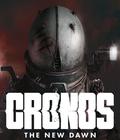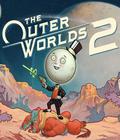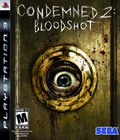Genre: Action/Puzzle
Publisher: Sega
Developer: Monolith Studios
Release Date: March 18, 2008
There's always an odd man out at any console launch, a game for whatever reason — too quirky, too genre-bending or blending, too awful — to sell well outside the context of limited launch lineups. This is, of course, usually why the title is marketed day-one alongside the one hopeful system-seller and an abbreviated list of also-rans. At Xbox 360's launch, the odd man was probably Condemned: Criminal Origins. Whereas the original title was a curious amalgam of adventure, action and puzzle-solving via the protagonist police detective's murder investigation, the sequel, Condemned 2: Bloodshot, is far more a horror/action experience, more akin in spirit, if not detail, to developer Monolith's signature F.E.A.R. (now Project Origin) franchise — and it's a better game for it.
Graphically, Bloodshot is as advanced as you'd want from a PlayStation 3 title more than a year after the console's launch, but the game is not photo-realistically impressive. Bloodshot achieves most of its graphics prowess by good art direction, in mood and imagery. Indeed, common to many horror or "startle" games, near pitch-dark environments predominant; the benefit here for the studio is that barely making out the details of settings and enemies is an integral part of the game. If the models and textures don't consistently impress, it's irrelevant because most of the time, you can't see them well enough to be disappointed.
Animations in Bloodshot are acceptable overall, although typically less than lifelike. At first glance, F.E.A.R.'s animation work is far better, because that in that game, you're focused on the wonderfully implemented slow-motion animation effects put to use about every five minutes. If you sit back and watch enemy movement with that effect, you'll notice your opposition moves from place to place in beelines, foregoing realistic walking or running animations. Essentially, the animation work in Bloodshot is as good as in F.E.A.R. in exactly the same way: It's average, save for one particular aspect. Bloodshot's show-off animation sequences occur in the numerous close-quarters, melee combat. Obviously inspired by the cinematography of the gutter-pugilism scenes in the David Fincher's film adaptation of "Fight Club," fisticuffs rounds play out in a beautiful punch-drunk style. Often you find your rabid enemy staring you right in the face. I mean, right in the face. It doesn't make you jump, but it's damn frightening, and all you can think about for a moment is how to back away from that enraged thug or hideous creature.
Bloodshot's score suits the terror theme while still retaining a bit of the police-procedural orchestration that followed the more brass-tacks plot of the first game. Use of 5.1 discrete-channel audio is liberal and very good, one of only a handful of PS3 times making a premium A/V system truly worthwhile for gaming. Too often, games studios take a filmic approach to surround sound. It's arguable whether or not that approach in movies is merely cutting corners where you can to no detrimental effect, or if it is truly better for movies, but is not the best style for games; once you've heard a good discrete-channel audio production in a game, it's immediately noticeable how lacking most of them are in comparison.
The thing in games is channel separation. In a movie, it's reasonable you don't know or care that the actor speaking offscreen sounds like he's right inside the left-hand side of the shot. In a game, particularly in titles designed in first-person perspective, and especially in those with a fright factor, distinct channel separation is important. It'll either freak you out that something is over there babbling away, and it's getting louder so it must be coming at you, blindside, or you'll play far better in shooters hearing unseen enemies sneaking up on you from the sides or back. Bloodshot's sound effects audio production excels at proper channel separation, significantly increasing the creepiness of the whole experience.
As alluded to earlier, Bloodshot is heavily dependent on melee-style combat, with blunt objects or employing, with near as much, ahem impact, your fists. Perhaps incongruously, these parts of the game play a little bit like Fight Night. Granted, it's a weird, often grotesque, sometimes outright disturbing version of Fight Night, but it works, works well, and it's fun to play a game in the "Fight Club" vein that gets it right, as opposed to the abysmal movie-licensed effort released by Monolith's former publisher, Vivendi, five years after the film premiered in theaters. It's a good general rule in video games that movie versions of games show up long after their inspiration, not the other way around. The two-way adaptation path between movies and video games is perilous at best, and a long cooling-off period between theatrical or home video release and game doesn't help — Rockstar's The Warriors being the exception proving the rule.
The fighting controls depend upon shoulder buttons to get the left/right/right feel rather than Fight Night's superior analog stick approach, but in the larger context of a plot-based, non-sports title, this is plenty sufficient. Enough thug-pounding, and you'll fill your "chain attack" gauge, which means you can unleash devastating chain attacks by double-tapping shoulder buttons. They're only devastating if they work, however; and the execution thereof is dependent on pressing the proper buttons according to screen cues without getting popped in the face while you're at it. Be warned, the game is picky about the timing.
A limited selection of more traditional shooter-style weapons do turn up as the game progresses, and Bloodshot indeed provides more opportunities for gunplay than its predecessor. Overall, both in ranged weapons and melee combat, the sequel is a nicely refined, more robust version of the original.
The puzzle-solving, detecting element of the Condemned has not been excised from Condemned 2. More on-screen cues prompt you to enter "study evidence" mode. This is pretty straightforward stuff. Once in forensics mode, you look around and zoom in on likely objects of interest, your field kit transmitting imagery and collecting samples for later analysis. Our hero Ethan Thomas comes complete with Rosa, his own "C.S.I." technician type, to do the detail work. Rosa feeds results back to Ethan — you, of course — for assimilation via his second-nature detective instincts. In this regard, Bloodshot's approach to crime scene analysis is better than the wildly popular television program: Rosa is a sharp cookie, but she's just a lab tech, whereas the "C.S.I." cast of characters is more like bona fide police detectives toting microscopes and spray bottles full of aqueous Luminol.
Bloodshot is at heart a single-player campaign game, one of those titles that feature online multiplayer but ultimately, no matter how short the campaign, you're left thinking perhaps the effort to include online competitive modes would've been better spent on more single-player action. But online multiplayer is a big marketing point these days — if I had a nickel for every time I've heard a gamer say, "I won't waste my money on single-player-only games" — and, practically speaking, it costs less to develop a few online modes than it does to add another 12 hours of single-player content. Bloodshot has four multiplayer modes. All but one, Crime Scene, is a variation on the standard themes — "bum rush" is just "survival" mode described with a pun. Crime Scene, however, is unique in its own right: One team tries to discover and examine evidence, while the opposition tries to keep the good stuff hidden from prying eyes. On its face, it sounds tantamount to a Rainbow Six-style attack/defend mode, but owing to the plot subtext and the vastly different environment, it doesn't play that way at all. Interesting though Crime Scene may be, it's not enough to recommend Bloodshot as an online multiplayer game.
Monolith developed a couple of extra single-player modes outside the campaign, too. Instant Action is combat action based somewhat on scenarios extracted from campaign, no doubt familiar to fans of F.E.A.R. The other is a series of combat-based challenges, the first of which serves as an always-accessible practice arena for trying out your moves. Chiefly, these modes are, like the online multiplayer, included only to extend gameplay hours a bit beyond the relatively short campaign. They don't add much to Bloodshot, but they're not so poorly realized that they detract from the game, either.
I've said it before and I'll gladly repeat: I'd rather play a good, short single-player campaign than a mediocre combination of campaign and uber-option online multiplayer. The problem for developers and publishers is that contemporary gamers pine for the good old days when console games lasted forever, and the same people like to take the retail price of the title, divide by the average number hours required to finish the campaign, yakking up a couple of digits that are supposed to represent a game's value but are in fact just an arbitrary number. First, the good old days of console cartridges going on forever never really existed. Somebody has finished Super Mario Brothers in, I believe, five minutes and 17 seconds. People say they wouldn't want to live forever; I know why. Second, if you really want to play the "divide-by" angle, the dollar-per-hour of entertainment offered by full-price games beats the same for full-price, newly released DVD movies, quite handily if you consider that you may play that game every spare moment, even for just a couple of weeks, but after watching a DVD once or twice, it'll likely be awhile before you sit through it again.
Condemned 2: Bloodshot will stand well against the competition in action, horror and even most shooter games, just on the merit of being a sequel improving on the original, rather than slipping beneath its foundation like so much land-filled garbage. Also in the game's favor is the fact, as a 360 launch title, the original title is not available for PS3; Bloodshot is the first opportunity for Sony fans to enjoy what is now a solid, reasonably novel series — perhaps even a budding dual-platform franchise.
Score: 8.8/10
More articles about Condemned 2: Bloodshot











 In Condemned 2: Bloodshot you assume the identity of Ethan Thomas, former Serial Crimes Unit investigator, who has been called back to duty to track down his missing partner.
In Condemned 2: Bloodshot you assume the identity of Ethan Thomas, former Serial Crimes Unit investigator, who has been called back to duty to track down his missing partner.



































